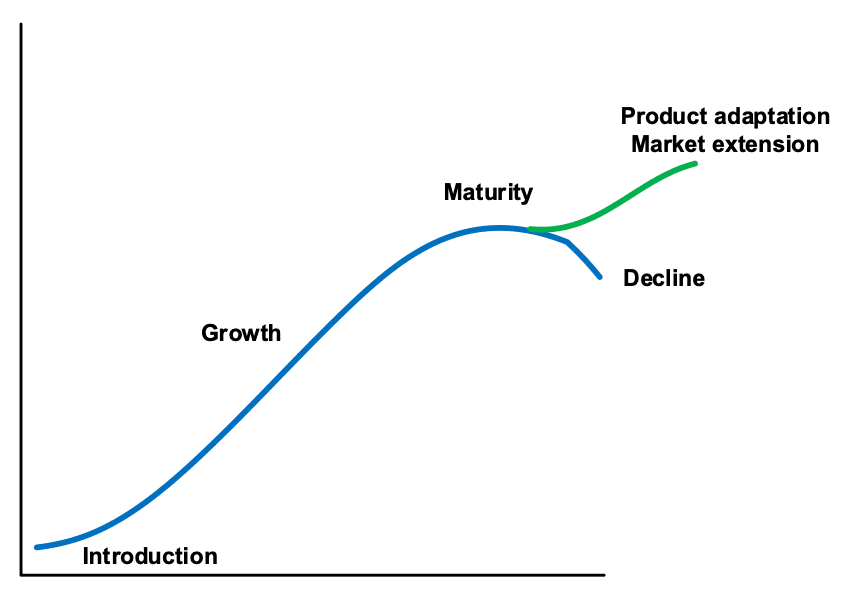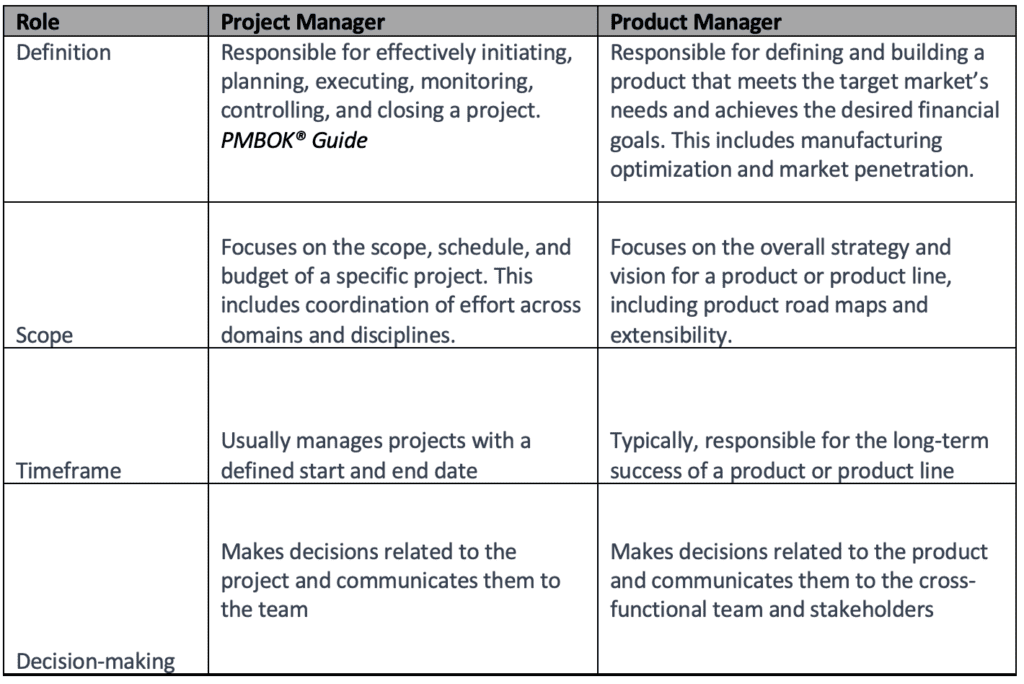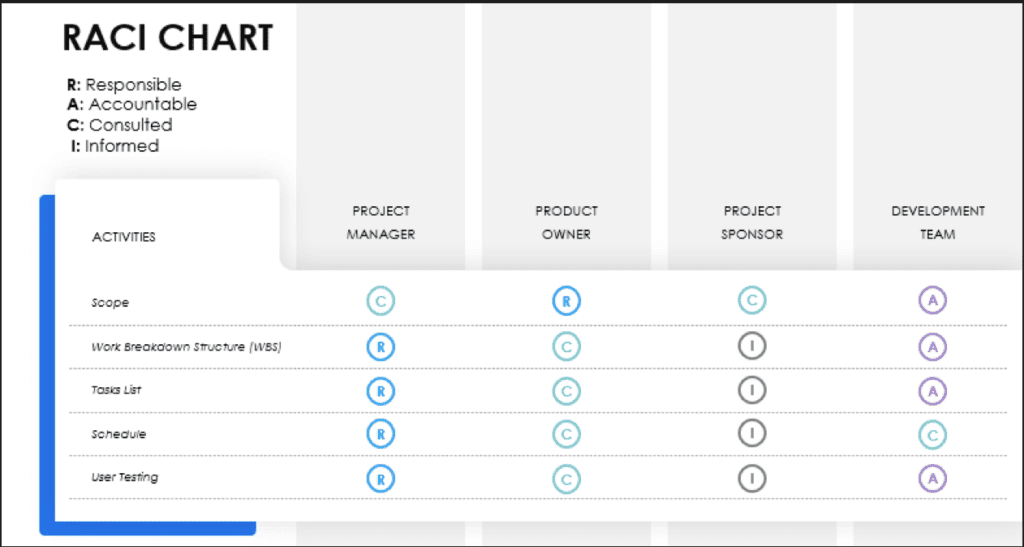First, I want to thank MPUG for making it possible for us to write this Transformation Corner column. We will have a variety of writers and topics on project management. Our team members have experience in product development and IT, construction, and military. The common theme will be project management relating to “hard” – and what is often referred to (errantly) as “soft” – elements.
We wanted to begin with an interesting query we have seen about Product and Project Managers. Both product and project domains are required to bring a product to market that meets the customer’s demands. These are not the same thing, and defining who does what is difficult, as there are so many industries and variations. However, it is interesting to explore the contents of these domains, and how their overlapping skills combine to effectively bring products to market. For best results, it’s important to understand these roles and define expectations up front.
Defining Product Development
Product development is creating and bringing a new product to market. It involves a series of steps: idea generation, market research, design, prototyping, testing, manufacturing, and marketing. Product development aims to create a product that meets the needs and desires of consumers and is feasible to produce and sell at a profit for the organization to grow and stay in business. It requires a strong understanding of customer needs and market trends, the competitive landscape and knowledge of engineering and manufacturing processes. Successful product development requires a collaborative effort from teams of professionals with diverse skills, including designers, engineers, marketers, and business strategists. The thing about product development is that a dogmatic approach is often not the best. This is especially true for something with as much variation as product development. Industries vary, and so too do organizations, staffing levels, and skills available. Additionally, projects are fraught with variations that require adaptation or tailoring the approach specifically for the opportunities and constraints presented.

For clarity, product development is not always a brand-new endeavor. There will be an initial project to deliver the first incarnation of the product. Subsequently, there will be additional projects to extend the product or adapt it to market conditions or result from things we learn about the product from the customer’s interactions with it. These opportunities will open up additional projects to change the product. There can be many projects in the product’s lifecycle, as the organization attempts to make the most of what has already been done while fulfilling the customer’s needs. The Product Manager will be required to engage in the effort to update the product, no matter the size of the project. This proposed product growth will often appear on a product roadmap that will fall under the purview of the Product Manager.
Product Development Steps
Though the generalized steps are relatively common, organizations vary in how they approach their goals, even within the same industry. Depending upon the nature of this product development project, only some of these steps may be required.
- Idea Generation: This is the first step in the product development process. It involves brainstorming and coming up with new ideas for products that can meet the needs of your target market.
- Market Research: Once you have a list of ideas, it’s essential to conduct market research to determine the feasibility of these ideas. This includes analyzing the market demand, competition, potential costs, and revenue.
- Product Design: After completing market research, you can start to design your product. This involves creating prototypes, testing them, and refining the design to ensure that the product meets your desired specifications.
- Manufacturing: Once the product has been designed and tested, it’s time to start mass-producing it. This may involve sourcing materials, setting up production lines, and managing to manufacture.
- Product and Process Testing: Before mass-producing the product, it’s essential to conduct thorough testing to ensure that it meets all relevant safety and quality standards. This may include lab testing, focus groups, and other forms of testing to ensure the product is ready for market.
- Marketing and Sales: With the product ready for market, it’s time to start promoting and selling it. This may involve creating marketing campaigns, building a sales team, and developing partnerships with retailers and distributors.
- Customer Support: Once the product is sold, the company may be required to provide ongoing customer support to ensure that customers are satisfied with the product and to address any issues that may arise.
- Continuous Improvement: The product development process doesn’t end with the initial launch. It’s essential to continue monitoring the product’s performance and making necessary improvements to remain competitive in the market.
Product Development Areas
There are many knowledge areas or domains required to deliver a product successfully. Examples of some of these are listed below, although this list is not exhaustive. Each of these broad areas can have many associated knowledge and management areas.
- Product Strategy and Planning
- Product Design and Engineering
- Product Marketing and Positioning
- Product Management (Product Roadmap)
- User Experience Design
- Quality Assurance and Testing
- Production and Manufacturing
- Product Launch and Rollout
- Product Pricing and Monetization
- Product Analytics and Metrics
- Project Management
This does not imply that all of these are required for every product development exercise. For example, projects modifying an existing product will likely require a reduced number of domains commensurate with the demands of the product update proposed.
Product Manager
To understand the general scope of the work, we will review the generally regarded areas of expertise of the Product Manager and the Project Manager.
A Product Manager is a professional responsible for a product’s development and lifecycle management. This includes researching, defining, and prioritizing features, working with cross-functional teams to bring the product to market, and analyzing and reporting on product performance. Product Managers typically have a background in business, marketing, or engineering, and may work in various industries, including technology, consumer goods, and healthcare.
The specific responsibilities of a Product Manager may vary depending on the organization and the product, but some everyday tasks include:
- Conducting market research to understand customer needs and identify opportunities for new products or product improvements.
- Defining the product vision and strategy, including setting goals and objectives for the product.
- Collaborating with cross-functional teams, including engineering, design, and sales, to develop and execute the product roadmap.
- Managing the product cost budget and resources, including allocating resources and setting priorities.
- Tracking and analyzing product performance metrics to identify trends and areas for improvement.
- Communicating the product vision and roadmap to stakeholders, including senior leadership and external partners.
Overall, the goal of a Product Manager is to create a successful product that meets customers’ needs and drives business growth. This includes the growth plans for the product.
Defining the Role of Project Manager
A Project Manager is responsible for planning, coordinating, and implementing a specific project within an organization. They are usually responsible for managing all aspects of the project, including a budget, timeline, resources, and communication with stakeholders. They work closely with the project team to ensure that the project is completed on time and within budget, and resolve constraints via executives, so that the product meets the goals and objectives set by the organization. Project Managers often have a background in business, engineering, or a related field and are skilled in project management techniques and methodologies.
Some methodologies include:
- Managing project budgets and resources.
- Setting Project Goals and objectives.
- Developing project schedules and timelines.
- Communicating with project stakeholders and team members.
- Coordinating project tasks and activities.
- Resolving project issues and conflicts.
- Tracking project progress and performance.
- Managing project risks and identifying potential problems.
- Ensuring project deliverables meet quality standards.
- Providing leadership and motivation to the project team.
- Managing and negotiating project contracts.
- Ensuring project compliance with relevant regulations and laws.
- Reporting project status and updates to higher management.
- Managing and maintaining project documentation.
- Making decisions and taking action to ensure project success.
Comparing Project Manager and Product Manager
Product development requires considerable coordination of many domains and talent areas. I have been developing products and studying product development for quite some time. At one time, there would typically be a technical Project Manager who would be responsible for product and project activities. However, this was in the particular domain of automotive product development.

As we can see, there are a variety of expertise and domain skills required in developing the product. The intersection of Product and Product Manager refers to the overlap between the roles and responsibilities of a Product Manager, and the development and management of a product.
A Product Manager and a Project Manager both play essential roles in the development and successful launch of a product. A Product Manager is responsible for defining and executing the product strategy, while a Project Manager is responsible for coordinating and managing the development and delivery of the product. While the roles are distinct, there is often overlap and collaboration between the two positions, as both are focused on ensuring the successful development and launch of a product.
Success!
The project’s success rests on the collaboration between the team, Project Manager, and Product Manager. There is an intimate connection between the plan for the project and the product plans. Specifically, the connection lies in the actions we take to meet those areas, as defined in this article’s Product Development Steps section. The actions we take to achieve these objectives can vary significantly from industry to industry and project to project, and based upon circumstance, will always impact how we approach the work.
From experience over the years, the scope of the Product Manager varies, even within the same industry. We likely all recognize that, in general, roles and responsibilities morph over the years. This is one of the reasons for understanding specific areas of responsibility. Our approach need not have a heavy level of formalism, but we should capture the expectations of one another at the beginning. This is one of the reasons for a RACI matrix, as briefly demonstrated below.

Summary
A Product Manager is responsible for the strategy and vision of a product or service. They focus on understanding the market and customer needs, and work with the development team to create and deliver a product that meets those needs. A Product Manager is often responsible for the entire product life cycle, from conception to launch to end-of-life.
A Project Manager, on the other hand, is responsible for the planning, execution, and delivery of a specific project within an organization. They work with a team to refine the project’s scope, break down the work, create a schedule, allocate resources, and ensure the project is completed on time and within budget. A Project Manager may work on multiple projects concurrently, but they do not have overall responsibility for the strategy and vision of the product or service.
A successful product development project requires close collaboration with the Product Manager, Project Manager, and development team. The project’s objectives, constraints, and assets vary even in the same organization and other similar product projects. It is sound advice not to assume the responsibility distribution, even when there are detailed position profiles. This is especially valid for product development projects where significant learning and adapting is required.
“But you are making assumptions without all the facts, and that’s not a sign of intelligence.” – C.C. Hunter



